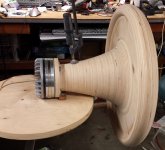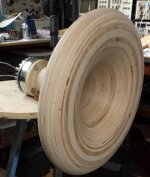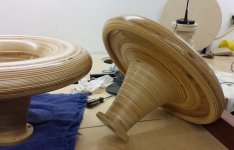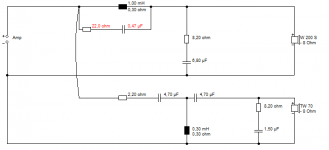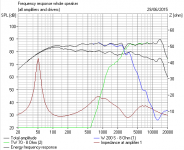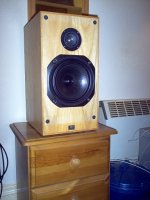DanVeyron
Very nice wood work you've done there. Now make an elliptical horn, that would be fun. I've done some work like you are showing here but it isn't for the faint of heart or the tool challenged builder. A LeCleach in wood would be a very interesting piece to look at.
Very nice wood work you've done there. Now make an elliptical horn, that would be fun. I've done some work like you are showing here but it isn't for the faint of heart or the tool challenged builder. A LeCleach in wood would be a very interesting piece to look at.
oltos,
I have talked to Jon Ver Halen ( I own DX-4s' )and Nelson Pass at several audio shows and have listened to Jon's Lowther / open baffle speaker system driven by Pass electronics many times. Jon and Nelson are both very nice, VERY smart, make excellent products and hold back no secrets. The DIY community has benefitted greatly from their knowledge and very lucky to have them.
I personally benefitted from the help / knowledge of Dr. Bruce Edgar, Jeffrey Jackson, Jack Elliano and several others over the years and will always be grateful. I now belong to two audio clubs in the NYC area and get to hear different speaker / electronics combinations from various club members and can tell you DIY is alive and well. I live in Brooklyn, and if you would like, I invite you over to my house to listen to my horn system. I have several pairs of SET mono blocks to play with. This is my small way of giving back to the audio community. Since you are trying to put together a "high efficiency" speaker system at least you will have a reference point---plus you live only 30 miles away so no flight will be required !!! If you are interested, email me at joesnipe767@yahoo.com.
Joe
I have talked to Jon Ver Halen ( I own DX-4s' )and Nelson Pass at several audio shows and have listened to Jon's Lowther / open baffle speaker system driven by Pass electronics many times. Jon and Nelson are both very nice, VERY smart, make excellent products and hold back no secrets. The DIY community has benefitted greatly from their knowledge and very lucky to have them.
I personally benefitted from the help / knowledge of Dr. Bruce Edgar, Jeffrey Jackson, Jack Elliano and several others over the years and will always be grateful. I now belong to two audio clubs in the NYC area and get to hear different speaker / electronics combinations from various club members and can tell you DIY is alive and well. I live in Brooklyn, and if you would like, I invite you over to my house to listen to my horn system. I have several pairs of SET mono blocks to play with. This is my small way of giving back to the audio community. Since you are trying to put together a "high efficiency" speaker system at least you will have a reference point---plus you live only 30 miles away so no flight will be required !!! If you are interested, email me at joesnipe767@yahoo.com.
Joe
But first, the system for my spare bedroom: That room’s only 12 ft x 13; kind of laughable proportions to be spending serious money and effort on, I suppose. But does this also mean that it’s pointless to build a system that can get down to between 35 and 30Hz? If not, then clicking on each link at this page http://www.rythmikaudio.com/technology.html , I’d really appreciate your assessment of each of the design aspects of this particular 12” sealed servo sub.
Not only does this design seem to place it among the very best powered commercial subs around, but I reasoned that if I didn’t EQ it to go down below 35Hz to 30Hz, that distortion-including up to its usable high end band-would be further minimized.
Also, Rythmik does make the same sealed sub and servo electronics in a 15” version. However, designer Brian Ding-and Jim Salk, who builds his own improved cabinets for Rythmik drivers-assured me that a pair of 12” subs would easily fill even my 14 ft by 18 living room and that the 15” would just play louder.
As for above 100Hz, just as my bedroom is probably too small for passive 15” sealed woofers-including Gary’s 26” wide sealed Altec 416 midwoofers-how about the Tone Tubby 12” Alnico as a substitute for the 416? I see here http://www.nutshellhifi.com/MLS/MLS6.html that you heard and measured it in an open baffle. Though it may have sounded wonderful in OBs, placed in a large enough room, would the TTs low end be extended to as low as 100Hz to 80Hz in a sealed box? If yes, then the paper coned Rythmiks’ crossovers should have no trouble blending with them, yes?
But to get an undistorted 100Hz to 80Hz range (70Hz?) out of the TTs, can you estimate what size sealed box I’d need?
Now for the highs: Would the TTs blend well with the SEAS T35 tweeter
https://www.madisoundspeakerstore.com/seas-soft-dome-tweeters/seas-exotic-t35-x3-06-tweeter-with-alnico-magnet/ -particularly if it was fitted with this waveguide http://www.troelsgravesen.dk/TQWT-DTQWT-mkII-T35.htm ?
Alternatively, I recall reading that you were very fond of RAAL ribbons. Would the TTs work as well or better than the T35-wth a particular model RAAL ribbon, in my small room? If yes, please recommend the best applicable model https://www.madisoundspeakerstore.com/index.php?p=catalog&mode=search&search_in=all&search_str=raal And would they be easy to cross with the TTs, especially since I’m bi-amping?
Lastly, in your review of the TT, you stressed its superb midrange. Were it otherwise,would your driver of choice to cross above the TT be Rob Mackinlay’s mini ESLs http://www.eraudio.com.au/Mini_Panels/mini_panels.html ? Indeed, as you say here
http://www.nutshellhifi.com/library/speaker-design1.html , nothing touches the midrange quality of ESLs. Of course, their highs probably don’t extend to where the RAAL ribbons can go.
OR might there be a horn to use above TT that you think I’d like better than any of the above drivers-even a RAAL ribbon? However, please bear in mind that the only horn systems I can ever recall hearing were the Altec A-4X, A-5X and/or A-7 back in the 80s here
http://www.in70mm.com/news/2003/syosset/ Needless, to say, if those horns had the sizable distortion issues that I might have read about, Gary’s horns and those you strongly recommend certainly must sound better by magnitudes.
So which of all these HF drivers would you choose to work with the sealed TTs in my tiny room?
The hempcone Tone Tubby's are high-Qts guitar speakers, which means they'll get very boomy if put in any kind of box. I'm also pretty sure they have unity-hung VC's with little or no linear excursion ... guitar speakers are intended to have a "voice" as part of a musical instrument, with the player changing the sound through dynamic expression. The TT's are basically open-back low-midranges, in other words.
Zooming out to the more global issues brought up in your post, I think you need to back up a few steps and ask what you'd like to accomplish with your new speaker. What are your subjective goals? This is a serious question.
The goals with my "Beyond ..." was to retain the sweet and spatially open character of the Ariels with the vivid tone colors and effortless dynamics of high-efficiency speakers. Based on the early prototypes I've heard and Gary Dahl's feedback, I'm 90% there.
Each transducer technology has an inherent sound. This isn't just a matter of tonal coloration (some of which can be equalized away), but of dynamic character. Electrostats are wonderfully clear until they hit the dynamic wall, and are very difficult to get a gutsy, physical sound out of. The drums and pianos rarely convince ... but choirs are wonderful and amazing.
Direct-radiator dynamics, by comparison, are "dirtier" sounding but done right, can have a very nice sense of impact. This sense of impact, though, is not always found in OB speakers. Done wrong, an OB can combine the vagueness of dynamic drivers with the thin, non-physical sound of electrostats. Done right (and the Spatial seems to come the closest) they sound spacious and bass quality is still pretty decent.
Horns pretty much own dynamics, and against expectation, retain their trademark clarity and vividness at very quiet playback levels. Many audiophile-class direct-radiator drivers get all dull when played quietly. (Most high-end speakers only sound good at one, fairly loud, playback level, and are not a good choice for casual listening.)
If casual background listening is the primary goal, fullrange backhorn-loaded speakers are the first choice. They sound cohesive and effortless when played at quiet and medium levels, and there are never any issues with the dynamic tracking of different drivers at different levels.
Returning to amplifiers, the Pass amps sound quite different than 45 or 300B direct-heated triode amplifiers. I tried a Nelson Pass amp with the Ariels back in the Nineties, and the combination didn't work at all. I've also heard them at hifi shows, and it's just not my thing.
Not particularly a fan of Lowthers either, so I'm definitely not the guy to ask about Pass amps, Lowthers, or Fostex full-range speakers. I live over in 300B-land, and definitely like the Western Electric and Altec sound. I'm not a collector ... ugh ... but I am very interested in why WE and Altec sound the way they do.
Musically, I like symphonic, choral, Pink Floyd studio rock, German techno, and London/Ibiza dance music. Don't care about jazz or bluegrass or hip-hop. So the usual audiophile favorites are of no interest whatever. I like a big, vivid Technicolor sound that is very spatial and 3D, and design my system so it does just that. I invented and patented the Shadow Vector quadraphonic decoder in 1975, so ambient impression and spatial qualities have always been important.
Your musical tastes are probably different. The things that turn you on musically should guide your choice of technology. I hate to say this, but hifi reviewers have pretty weird-sounding systems at home, so I wouldn't use magazine reviews as a guide. This is why the outer fringes of DIY, along with specialist manufacturers you never heard of, are useful if you want to find what works for you.
Last edited:
Endlessly interesting thread as usual. Wonderful woodwork too. I'm not sure these ugly horns have much WAF, but I know the elegant tractrix horn Pseudosphere from geometry. Constant negative Gaussian curvature. Something special.
I really don't know what a high dynamics direct radiator tweeter is actually. I think I've got the hang of high Qms and matched dispersion though.
What I wanted to say to you, Lynn, is a I found an updated interview with Robin Marshall. He seems to be on the high dynamics path these days too, after all those terrific commercially successful speakers he worked on years ago. The JBL 1400 and the Yamaha NS1000 get the nod form him in different styles.
http://www.diyaudio.com/forums/multi-way/147632-classic-monitor-designs-24.html#post4372572
In fact, if you ask me, everybody worth knowing does high dynamics these days. Whatever the precise style, it wins a cigar.
I really don't know what a high dynamics direct radiator tweeter is actually. I think I've got the hang of high Qms and matched dispersion though.
What I wanted to say to you, Lynn, is a I found an updated interview with Robin Marshall. He seems to be on the high dynamics path these days too, after all those terrific commercially successful speakers he worked on years ago. The JBL 1400 and the Yamaha NS1000 get the nod form him in different styles.
http://www.diyaudio.com/forums/multi-way/147632-classic-monitor-designs-24.html#post4372572
In fact, if you ask me, everybody worth knowing does high dynamics these days. Whatever the precise style, it wins a cigar.
Drilling down a little more, the whole ceramic/Alnico thing is mostly of interest to pretty far-gone direct-heated triode enthusiasts, the kind of nutcases who go on and on about the sound of nickel vs M6 transformer cores, the sound of interstage coupling versus RC coupling, the gutsiness of pure-pentode vs the air and beauty of DHT sound, and so on. Yeah, I'm one of them. That's where I live. Stuff like that matters to us. I suspect it has no interest whatsoever to most hifi fans, never mind the MP3-listening general public.
if you are on that wavelength ... and you guys know who you are ... yes, it's important, and very annoying that Alnico is treated as some really exotic, way-out thing. It was universal back in the Fifties, and found in Magnavox TV speakers, theater systems, and just about every hifi speaker. It was everywhere and nothing special at the time. Ceramic magnets didn't appear until the early Seventies, when a Cold War proxy conflict in Africa made cobalt hard to get (and mostly reserved for military applications).
Translating into human-speak, the Alnico thing is about tone, which is what 300B's and other direct-heated triodes are about. Shimmering and vivid tone. As crude as Fifties-tech was, it did tone really well, and even plain old Zenith AM/FM table radios had really great tone. It was kind of everywhere ... radios, TV sound, theaters, and big-rig hifi systems. It's just how things sounded then, and the music emphasized that (Frank Sinatra and classical dominated the radio ... rock music was kind of a niche thing).
Tone slowly faded out after transistors wiped out tubes in the late Sixties, ceramic magnets replaced Alnico in the early Seventies, and Compact Discs followed by MP3 compression did the final touches a few decades later. The market (and technology) emphasis shifted to loud and "clean", with lots of 40~60 Hz bass, and a sharp metallic edge around 5 kHz. The audiophile market likes to stand aside from mass-market preferences, but it's still influenced by them.
Interestingly, tone and spatial qualities usually go hand in hand. A mass-market home theater receiver may have 7-channel sound, but the spatial qualities are almost entirely absent, despite speakers being located all around the room. Mostly, the sound comes right out of the speaker, and there's very little sense of room engagement.
if you are on that wavelength ... and you guys know who you are ... yes, it's important, and very annoying that Alnico is treated as some really exotic, way-out thing. It was universal back in the Fifties, and found in Magnavox TV speakers, theater systems, and just about every hifi speaker. It was everywhere and nothing special at the time. Ceramic magnets didn't appear until the early Seventies, when a Cold War proxy conflict in Africa made cobalt hard to get (and mostly reserved for military applications).
Translating into human-speak, the Alnico thing is about tone, which is what 300B's and other direct-heated triodes are about. Shimmering and vivid tone. As crude as Fifties-tech was, it did tone really well, and even plain old Zenith AM/FM table radios had really great tone. It was kind of everywhere ... radios, TV sound, theaters, and big-rig hifi systems. It's just how things sounded then, and the music emphasized that (Frank Sinatra and classical dominated the radio ... rock music was kind of a niche thing).
Tone slowly faded out after transistors wiped out tubes in the late Sixties, ceramic magnets replaced Alnico in the early Seventies, and Compact Discs followed by MP3 compression did the final touches a few decades later. The market (and technology) emphasis shifted to loud and "clean", with lots of 40~60 Hz bass, and a sharp metallic edge around 5 kHz. The audiophile market likes to stand aside from mass-market preferences, but it's still influenced by them.
Interestingly, tone and spatial qualities usually go hand in hand. A mass-market home theater receiver may have 7-channel sound, but the spatial qualities are almost entirely absent, despite speakers being located all around the room. Mostly, the sound comes right out of the speaker, and there's very little sense of room engagement.
Last edited:
I'm really not sure whether valves were what provided that lovely tone anymore. I know exactly what you are talking about Lynn. My Dad's radiogram had room filling tone in spades. Voltage or current drive can get you there if the impedance is flat IMO:
And TBH, I get a nice tone from some current efforts. Even with solid state and CD and ferrite speakers. This is with lively drivers.
But there is work to do on magnetic materials. Which really is the WORST non-linear crossover component in measurable ways. I have real trouble with this 7kHz tank notch across a ferrite bass coil. It adds something good, but gets harsh. I don't know if that is distortion from the coil ferrite in a highly resonant circuit, or a rocking mode from the bass.
A bridge technique might be the real way to compare AlNiCo to ferrite and even air coils.
Perhaps I should buy some good air coils and sort it out! Images more to explain myself well than promotion of particular styles.
An externally hosted image should be here but it was not working when we last tested it.
And TBH, I get a nice tone from some current efforts. Even with solid state and CD and ferrite speakers. This is with lively drivers.
But there is work to do on magnetic materials. Which really is the WORST non-linear crossover component in measurable ways. I have real trouble with this 7kHz tank notch across a ferrite bass coil. It adds something good, but gets harsh. I don't know if that is distortion from the coil ferrite in a highly resonant circuit, or a rocking mode from the bass.
A bridge technique might be the real way to compare AlNiCo to ferrite and even air coils.
Perhaps I should buy some good air coils and sort it out! Images more to explain myself well than promotion of particular styles.
Attachments
oltos, I have talked to Jon Ver Halen ( I own DX-4s' ) and Nelson Pass at several audio shows and have listened to Jon's Lowther / open baffle speaker system driven by Pass electronics many times. Jon and Nelson are both very nice, VERY smart, make excellent products and hold back no secrets. The DIY community has benefitted greatly from their knowledge and very lucky to have them.
I personally benefitted from the help / knowledge of Dr. Bruce Edgar, Jeffrey Jackson, Jack Elliano and several others over the years and will always be grateful. I now belong to two audio clubs in the NYC area and get to hear different speaker / electronics combinations from various club members and can tell you DIY is alive and well. I live in Brooklyn, and if you would like, I invite you over to my house to listen to my horn system. I have several pairs of SET mono blocks to play with. This is my small way of giving back to the audio community. Since you are trying to put together a "high efficiency" speaker system at least you will have a reference point---plus you live only 30 miles away so no flight will be required !!! If you are interested, email me at joesnipe767@yahoo.com.
Joe
Wow, an actual invitation from someone at diyaudio.com to hear their personally designed and built system-and only train and/or subway ride away! Once I get a handful or two of my questions answered here, so that I can at least partially move towards speaker designs that complement my musical and sonic tastes, I will be delighted to arrange a mutually convenient date for this event. Btw, are you strictly vinyl or would you happen to also have a DAC? I hope to play some WAV files from a cross section of musical genre-and to do so via my laptop’s Samplitude DAW software, which allows me some interesting options with certain musical selections. But most of all, I hope to determine how much I might like at least one kind of horn system for what percentage of my musical catalog. Thanks again, for this rare and very generous invitation!
Note: with respect to the T35..
I once had a discussion on the fullrange forum with someone that took a chance on this tweeter and I believe was quite pleased with the result.
Oddly, it was their (seas) alnico fullrange driver that he wasn't pleased with - where he decided on the Supravox 285, and was *very* pleased with that driver (in conjunction with the seas T35).
Of course the Supravox is an 8" driver with a very different directivity pattern below about 1.4 kHz when compared to a 15" driver.
..might want to consult Dave Pellegrene about a larger custom low-depth waveguide to accompany the T35: acoustic waveguides
QUOTE]
Thanks Scott for a T35 success story when used with these drivers. But which Supravox 235? There are a few of them here, but I don't see any 8", only 12". Which alnico Supravox do you mean? Supravox drive units
Shimmering and vivid tone
yes this is the difference in guitar speakers when overdrive come in ,smooth shimmering vs harsh in ceramic .
most don't know that 90% of guitar pickup is in alnico and we use to swap for alnico 2-3-4-5-8 just to change the sound ,ceramic is for metal or higain stuff
Drilling down a little more, the whole ceramic/Alnico thing is mostly of interest to pretty far-gone direct-heated triode enthusiasts, the kind of nutcases who go on and on about the sound of nickel vs M6 transformer cores, the sound of interstage coupling versus RC coupling, the gutsiness of pure-pentode vs the air and beauty of DHT sound, and so on. Yeah, I'm one of them. That's where I live. Stuff like that matters to us. I suspect it has no interest whatsoever to most hifi fans, never mind the MP3-listening general public.
if you are on that wavelength ... and you guys know who you are ... yes, it's important, and very annoying that Alnico is treated as some really exotic, way-out thing. It was universal back in the Fifties, and found in Magnavox TV speakers, theater systems, and just about every hifi speaker. It was everywhere and nothing special at the time. Ceramic magnets didn't appear until the early Seventies, when a Cold War proxy conflict in Africa made cobalt hard to get (and mostly reserved for military applications).
Translating into human-speak, the Alnico thing is about tone, which is what 300B's and other direct-heated triodes are about. Shimmering and vivid tone. As crude as Fifties-tech was, it did tone really well, and even plain old Zenith AM/FM table radios had really great tone. It was kind of everywhere ... radios, TV sound, theaters, and big-rig hifi systems. It's just how things sounded then, and the music emphasized that (Frank Sinatra and classical dominated the radio ... rock music was kind of a niche thing).
Tone slowly faded out after transistors wiped out tubes in the late Sixties, ceramic magnets replaced Alnico in the early Seventies, and Compact Discs followed by MP3 compression did the final touches a few decades later. The market (and technology) emphasis shifted to loud and "clean", with lots of 40~60 Hz bass, and a sharp metallic edge around 5 kHz. The audiophile market likes to stand aside from mass-market preferences, but it's still influenced by them.
Interestingly, tone and spatial qualities usually go hand in hand. A mass-market home theater receiver may have 7-channel sound, but the spatial qualities are almost entirely absent, despite speakers being located all around the room. Mostly, the sound comes right out of the speaker, and there's very little sense of room engagement.
It is all niche stuff. Some like al dome some like silk domes. Another hot debate. I like silk domes, but even for my classical interests the silk loses something like ferrofluid does, period. I actually got bored listening to silk domes. I prefer precision to damping out the frizzly stuff. It is too easy to lose very subtle low level detail. I cannot listen to most vinyl because the recordings were often poor for many different reasons. Although my best repro is with some limited vinyl. The same goes for many CD's.
Horns are also swings and round abouts. Another niche.
I will make the comment for those who are just starting or are not able to design a network that when you take a dome tweeter and mount that to a waveguide that the output frequency response is going to change significantly. There will be a definite tilt to the FR with a downward sloping change when you mount it to a waveguide. The network will have to change when you mount any dome tweeter to a waveguide, no way around that. Just be aware that a network designed for a tweeter alone will no longer be correct once you mount to a waveguide of any size.
Exactly. I have a TQWT from Troels Gravesen, using the Audax option instead more expensive T35 (not alnico model, the ferrite one). I have measured the Audax "pure" and with waveguide from TQWT project. The response changes dramatically at low end, so crossover needs to be specific to that application (hence not so usual values in crossover from this project). Most important, low freq THD reduces and one can use an little lower crossover frequency. Most dome tweeter distorts badly from 2kHz downwards, and these Audax measures low distortion even at 500Hz, with waveguide!I will make the comment for those who are just starting or are not able to design a network that when you take a dome tweeter and mount that to a waveguide that the output frequency response is going to change significantly. There will be a definite tilt to the FR with a downward sloping change when you mount it to a waveguide. The network will have to change when you mount any dome tweeter to a waveguide, no way around that. Just be aware that a network designed for a tweeter alone will no longer be correct once you mount to a waveguide of any size.
About sound signature? Well, very good, but is not a horn sound, to be sure. Even with waveguide one will recognizes the "sweet" dome sound, but with far more midrange/lower treble presence and dynamics than typical dome usage. I fear if these sound results "mellow" if pairing with some "hash" prosound driver, but maybe with different waveguide/horn... (By the way, the TQWT bass is based in waveguide system with 8" JA-8008, and I like these sound, is more dynamic and punching than all my previous sealed/TL/vented tentatives).
DIYBras,
I'm wondering which Audax tweeter you are using since I have been told Harmon closed them down once they took over? I happen to think that some of their tweeters were some of the best sounding soft domes out there and weren't very expensive. The current prices for he SEAS components is insane as far as I am concerned, nothing in the manufacturing or design justifies their prices but that is just my opinion. It surely doesn't make diy cost effective at those kinds of prices.
I've been considering how to price some of my 6 1/2" cone drivers, very different than what I see commercially available. I think the closest device would be the MarkAudio device but have no idea what they charge. I know this is a high efficiency crowd on this thread so it isn't appropriate here unless they were horn loaded.
I'm wondering which Audax tweeter you are using since I have been told Harmon closed them down once they took over? I happen to think that some of their tweeters were some of the best sounding soft domes out there and weren't very expensive. The current prices for he SEAS components is insane as far as I am concerned, nothing in the manufacturing or design justifies their prices but that is just my opinion. It surely doesn't make diy cost effective at those kinds of prices.
I've been considering how to price some of my 6 1/2" cone drivers, very different than what I see commercially available. I think the closest device would be the MarkAudio device but have no idea what they charge. I know this is a high efficiency crowd on this thread so it isn't appropriate here unless they were horn loaded.
My TQWT uses this Audax tweeter: https://www.madisoundspeakerstore.c...udax-tw034x0-1.3-textile-dome-tweeter-by-aac/, with Jantzen waveguide designed by Troels for the TQWT.
In my opinion and experience, is a excelent performer and hard to beat, in the domes world, even against some more expensive options. Very very clean sound, and distorts little even with high SPL output. The Seas is like an upgraded version of Audax model, and some people use them in TQWT project (for TQWT mkIII Troels only uses the Seas option). Troels says Seas is superior, but not by much, so both are in same class. Efficiency is equal to Seas model, so maybe someone can experiment with some horns to match it with Tone Tobby, for example. An friend of mine has an old Snell tower, with Audax TW025??? model, and sounds very good, so I consider Audax tweeters always an option for projects.
Fortunately Harman not change the Audax drivers quality... By the way, the Harman group bought Selenium here in Brazil some time ago, but little has changed for Selenium line, then we can hope to count for some time with Audax products.
Madisound is a place where you will find prices for MarkAudio drivers, but as it is a store, I can only imagine how much costs a raw MarkAudio driver direct from factory...
In my opinion and experience, is a excelent performer and hard to beat, in the domes world, even against some more expensive options. Very very clean sound, and distorts little even with high SPL output. The Seas is like an upgraded version of Audax model, and some people use them in TQWT project (for TQWT mkIII Troels only uses the Seas option). Troels says Seas is superior, but not by much, so both are in same class. Efficiency is equal to Seas model, so maybe someone can experiment with some horns to match it with Tone Tobby, for example. An friend of mine has an old Snell tower, with Audax TW025??? model, and sounds very good, so I consider Audax tweeters always an option for projects.
Fortunately Harman not change the Audax drivers quality... By the way, the Harman group bought Selenium here in Brazil some time ago, but little has changed for Selenium line, then we can hope to count for some time with Audax products.
Madisound is a place where you will find prices for MarkAudio drivers, but as it is a store, I can only imagine how much costs a raw MarkAudio driver direct from factory...
Thanks Scott for a T35 success story when used with these drivers. But which Supravox 235? There are a few of them here, but I don't see any 8", only 12". Which alnico Supravox do you mean? Supravox drive units
Sorry, it's not the 285, it's the 215.
You can get the 215 with Alnico OR Electro-Magnet versions.. (..though the EM needs a power supply).
The Alnico version (..and yes, it's not quite 8"s):
215-2000 SUPRAVOX
Note that the magnetic field is every bit up to Lowther standards at 2.1T
DIYBras,
I used the TWOA25 dome tweeter in many earlier designs I did. It was an excellent measuring tweeter, beat out many much more expensive dome tweeters time after time and they do sound very good. I was under the impression that the Audax name was going away, if not that is a good thing. I have my own design for a dome tweeter now and though I have been concentrating on a Be dome for that I will more than likely make a soft dome version also. most likely with a dome shape very similar to the Audax soft domes. The Be diaphragms by themselves for a 1" dome are priced at $35.00 dollars for the raw Be, no voicecoil or surround attached. A similar soft dome can be had for pennies, that will definitely greatly affect the price of a finished tweeter.
I didn't realize that the Markaudio drivers were all full range devices, I have only talked to Mark in the past and didn't realize that was the intent. I don't try to make my design full range and have much stronger bass output going down into the 35hz range in a larger enclosure. A very different approach and I make a custom made cone that nobody else has, a personal development.
Now back to the Beyond the Ariel thread.
I used the TWOA25 dome tweeter in many earlier designs I did. It was an excellent measuring tweeter, beat out many much more expensive dome tweeters time after time and they do sound very good. I was under the impression that the Audax name was going away, if not that is a good thing. I have my own design for a dome tweeter now and though I have been concentrating on a Be dome for that I will more than likely make a soft dome version also. most likely with a dome shape very similar to the Audax soft domes. The Be diaphragms by themselves for a 1" dome are priced at $35.00 dollars for the raw Be, no voicecoil or surround attached. A similar soft dome can be had for pennies, that will definitely greatly affect the price of a finished tweeter.
I didn't realize that the Markaudio drivers were all full range devices, I have only talked to Mark in the past and didn't realize that was the intent. I don't try to make my design full range and have much stronger bass output going down into the 35hz range in a larger enclosure. A very different approach and I make a custom made cone that nobody else has, a personal development.
Now back to the Beyond the Ariel thread.
Since 2007 Audax drivers are built by AAC, the brand is not owned by Harman anymore. Harman had bought Audax in 1987.
https://fr.wikipedia.org/wiki/Audax_(haut-parleurs)
https://fr.wikipedia.org/wiki/Audax_(haut-parleurs)
- Home
- Loudspeakers
- Multi-Way
- Beyond the Ariel
